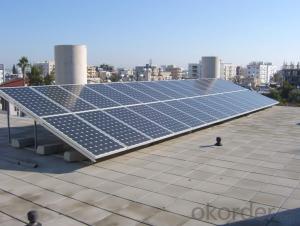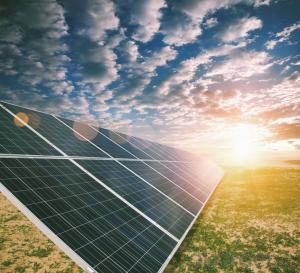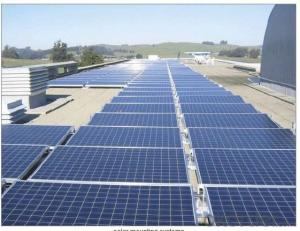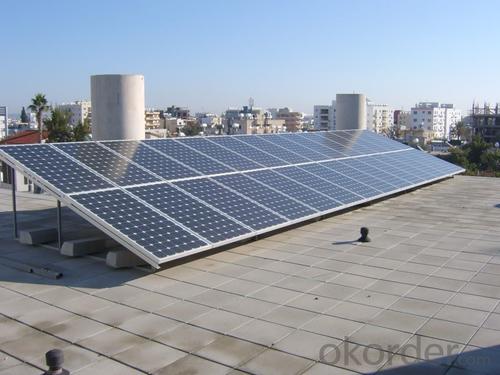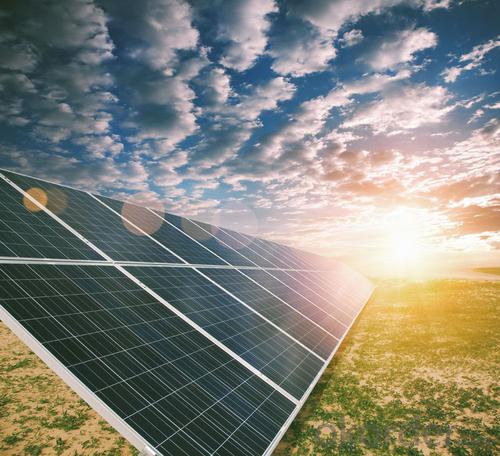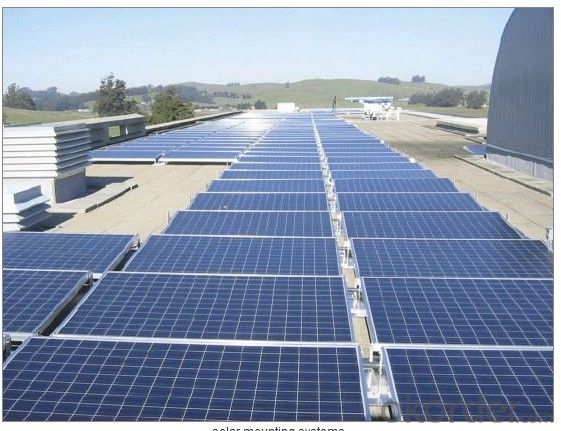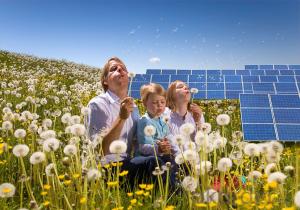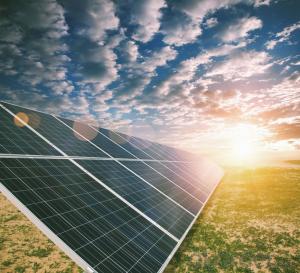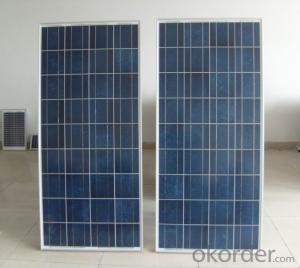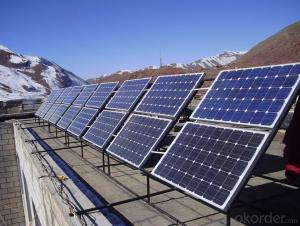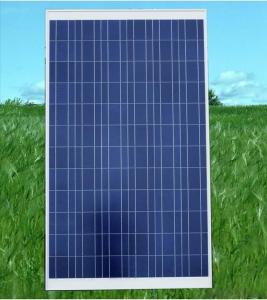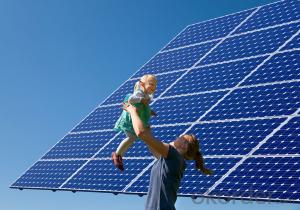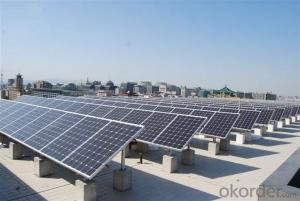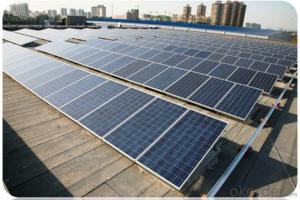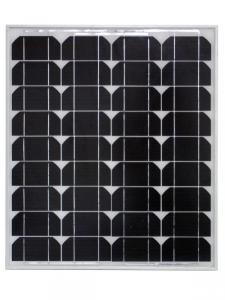Plastic Polycrystalline Silicon Solar Panels 255W
- Loading Port:
- Nanjing
- Payment Terms:
- TT OR LC
- Min Order Qty:
- 200000 watt
- Supply Capability:
- 20000000 watt/month
OKorder Service Pledge
OKorder Financial Service
You Might Also Like
INTRODUCTION
This installation Manual contains essential information for the electrical and mechanical installation that your must know before installing CUSTOMER PV modules. This also contains safety information you need to be familiar with .All the information described in this manual are the intellectual property of CNBM and based on the technologies and experiences that have been acquired and accumulated in the long history of CUSTOMER. This document does not constitute a warranty, expressed or implied.
CUSTOMER does not assume responsibility and expressly disclaims liability for loss, damage, or expense arising out of in anyway connected with installation, operation, use or maintenance of the PV modules. No responsibility is assumed by CUSTOMER for any infringement of patents or other rights of third parties that may result from use of PV module.
CUSTOMER reserves the right to make changes to the product, specifications or installation manual without prior notice.
Standard Test Conditions of Polycrystalline Silicon Solar Panel
The opto-electrical specifications shown below are stabilized values being measured at Standard Test Conditions of multicrystalline silicon Solar Panel, Irradiance: 1000W/m2, Spectrum: AM1.5 at 25°C, The info below is subject to manufacturing tolerances. Where appropriate minutes of measurement are available and are used for the dimensioning of the installation.
Advantages of Polycrystalline Silicon Solar Panel
A&M Solar performance guarantees for 25 years
12 years guarantee for workmanship for multicrystalline silicon Solar Panel
Timeliness of delivery
Quality Products certified (TÜV, UL, CE, VDE, ISO)
WORK PRINCIPLE
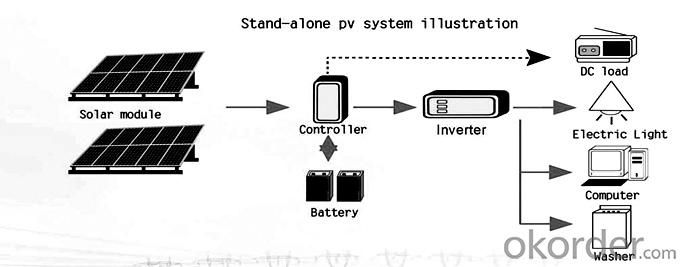
SITE SELECTION
In most applications, the PV modules should be installed in location where there is no shading throughout the year. In the Northern Hemisphere, The PV modules should typically face south, and in the Southern Hemisphere, the PV modules should typically face north. Please make sure that there are no obstruction in the surroundings of the site of installation. Take proper steps in order to maintain reliability and safety, in case the PV modules are used in areas such as: Heavy snow areas/Extremely code areas/ Strong wind areas/Installation over, or near, water/ Areas where installations are prone to salt water damage (*)/Small islands or desert areas.(*)
If you are planning to use the PV modules where the salt water damage may be possible consult with CNBM local agent first to determine an appropriate installation method, or to determine whether the installation is possible?
DATA SHEET
Maximum Power | 255W |
Efficiency | 0.157 |
Backsheet | White |
Frame Colar | Silver |
Manufacture Site | China |
Frame | Anodized Aluminum Alloy |
Weight | 19 kg |
- Q: Can solar panels be used in combination with other renewable energy sources?
- Yes, solar panels can indeed be used in combination with other renewable energy sources. Many renewable energy systems today incorporate a mix of solar panels, wind turbines, hydropower, and geothermal energy to maximize efficiency and ensure a reliable and sustainable power supply. This combination of different renewable sources allows for a more balanced and consistent energy generation, reducing reliance on a single source and increasing overall system resilience.
- Q: I need to power a series of meraki wireless repeaters that plug into a standerd wall outlet. consuming 5v or .08 amps However I need this in a remote location (like out in the middle of nowhere) Using A solar panel as power supply and a battery to store the energy but, how and what do I use to convert the energy coming from the solar panel to the battery and the batteries power supply to match the needs of the meraki wireless repeater? How do I make this as compact as possible? Do I need a ac/dc converter? or dc/ac converter? Any suggestions or solutions would be great !
- Search the web for some of the inexpensive solar Cell Phone Chargers. They can be hooked in series or parallel as needed to get you teh voltage and current needed. The 80mA is not too tough, thats not much current. Suggestion is to use a battery that is constantly trickle-charged by the solar panel. This will assure operation on a cloudy day or at night. Another strange source for solar panels and solar charge systems is, believe it or not, Harbor Freight Tools. they are on the web as well as have stores all over.
- Q: Can solar panels be installed on a boat or yacht?
- Yes, solar panels can be installed on a boat or yacht. Many boat and yacht owners opt to install solar panels to harness the sun's energy and power their electrical systems on board. These panels are typically mounted on the boat's roof or deck, and can provide a sustainable and renewable source of power for various applications while out on the water.
- Q: Do solar panels work in cloudy weather?
- Solar panels can still generate electricity in cloudy weather, though their efficiency may be reduced.
- Q: Ok so i have to solar panels to charge a battery however the panels hooked up in series does charge the battery very slowly because series connections only multiplies the voltage but leaves the current the same. Is there a way i can also hook both of them up in parallel at the same time to multiply the current for faster charge? I know i can do this with 4 panels but i dont want to spend extra. So is there a way to hook up 2 solar panels in series and parallel at the same time? Thanks in advace
- Homemade okorder /
- Q: Can solar panels be used for large-scale power generation?
- Yes, solar panels can be used for large-scale power generation. Large arrays of solar panels, known as solar farms or solar parks, can be installed to generate electricity on a larger scale. These solar farms can cover vast areas of land and produce significant amounts of power, which can be used to meet the energy demands of industries, communities, and even entire cities. Additionally, advancements in solar technology and the decreasing cost of solar panels have made large-scale solar power generation more economically viable and increasingly popular worldwide.
- Q: can solar panels be on houses? malls?stores? WHAT ABOUT TRAINS?
- Solar panels are, well panels that take solar energy from the sun, and use it as heat or electricity. It is used for many things but depending on the power of the sun and the panel, they can be used for trains,houses to heat them but you need a lot of sun, and they don't work without sun obviously.
- Q: i need technical and non technical details to generate MW power by solar panels
- I like Rouse's answer, which points to the factors to consider. If you are in India, adjust the inputs to match your local situation. For example, the peak equivalent sun-hours per day might be twice his figure, leading to half the cost. You might find panels that have a 25-year life, reducing the cost per kWh by another 20%. Land and/or labor may be cheaper, also reducing the cost.
- Q: but is that per day, per hour or minute?How much watts does the average AC unit use?How much does an energy efficient lightbulb use?All in all let's hypothetically say we no longer use the electric company for our energy source, How many of these panels do you estimate it would take to supply our small home?
- The watt is a measure of instantaneous output that can also be used as an hourly measure. volt at amp for hour = watt but also a 00watt bulb requires a 00watt power source, regardless of how long it is on, the 00watts is used as an instantaneous term here. Aircon starts at about 000watts and the new energy efficient bulbs are about 7-5 watts. If you have an electric cooker, that might use 3000 watts, your computer about 500 (very variabke these days though, many are now much lower than this) Your biggest concern would be storage, solar only works when the sun shines so you need a bank of batteries to charge during the day and provide power on demand, they require proper managenemt to ensure ther are charged properly and in turn, an inverter will be required to produce the AC power your appliances will need. It all represents a huge investment with a long payback time and you would still probably need to top-up with a generator during winter, or become ahmish.
- Q: I'm trying to charge rechargeable AA batteries with a solar panel. What gauge wire should I use to connect the panel to the batteries? I know I'm not going to have a lot of current going through so the wire size doesn't really matter. Can the wire be too thick thoShould I ugh? Should I use a diode to keep the batteries from overpowering the circuit? If so, what size diode? My panel is 4.8V 50mA. Can I just hook the panel straight into the batteries or do I need something else?
- In order: .? Just about any wire will do.? You can handle 50 mA over just about anything, even 28 gauge telephone wire.? Your biggest problems are probably going to be mechanical stress (you want stranded wire instead of solid, to avoid breakage) and dealing with the size of larger wires. 8 gauge speaker wire may be a good optimum. 2.? You need a diode.? If you're charging NiMH or NiCd cells you're going to have about .25 volts/cell; you can charge up to 3 of them in series with a 4.8 volt panel.? The solar panel is a bunch of diodes itself, but they're leaky in the reverse direction; the diode prevents the batteries from discharging themselves back through the panel.? You want a Schottky-barrier diode, because the forward voltage drop is about 0.2 volts instead of 0.7 volts for a regular silicon rectifier.? This gives you maximum current output from your panel.
Send your message to us
Plastic Polycrystalline Silicon Solar Panels 255W
- Loading Port:
- Nanjing
- Payment Terms:
- TT OR LC
- Min Order Qty:
- 200000 watt
- Supply Capability:
- 20000000 watt/month
OKorder Service Pledge
OKorder Financial Service
Similar products
Hot products
Hot Searches
Related keywords
